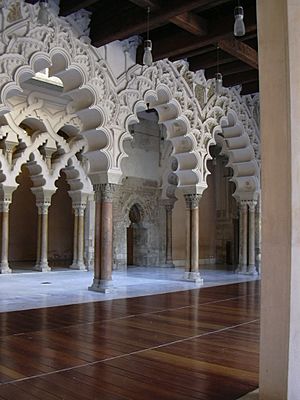Banu Hud facts for kids
The Banu Hud (pronounced Bah-noo Hood) were an Arab family. They ruled a kingdom called the taifa of Zaragoza in what is now Spain. Their rule lasted from 1039 until 1110. This period was part of a time when many small Muslim kingdoms existed in the Iberian Peninsula.
In 1039, a leader named Al-Mustain I, Sulayman ibn Hud al-Judhami took control of Zaragoza. He took it from another family, the Banu Tujib. The Banu Hud leaders who came after him were very interested in culture and art. These included Ahmad I al-Muqtadir (who ruled from 1046 to 1081), Yusuf al-Mutamin (1081–1085), and Al-Mustain II, Ahmad ibn Yusuf (1085–1110).
One of the most famous buildings from their time is the Aljafería palace. Ahmad I built this beautiful royal home. It is one of the few palaces from that period that is still almost completely standing today.
Contents
Banu Hud Rule in Zaragoza
The Banu Hud dynasty began when Sulayman ibn Hud took over Zaragoza. This city became the capital of their kingdom. Even though they were independent, the Banu Hud had to deal with powerful neighbors.
Paying Tribute to Castile
By 1055, the Banu Hud were forced to recognize the power of the kingdom of Castile. Castile was a Christian kingdom to their north. The Banu Hud had to pay parias to Castile. These were payments or tributes to keep peace and avoid attacks.
Fighting the Almoravids
In 1086, the Banu Hud led other smaller kingdoms. They resisted the Almoravids, who were a strong Muslim group from North Africa. The Almoravids wanted to conquer all of al-Andalus (Muslim Spain). They tried to take Zaragoza for many years.
The End of the Banu Hud Dynasty
The Almoravids finally conquered Zaragoza in May 1110. This event marked the end of the Banu Hud dynasty's rule in the city.
Alliance with Aragon
The last Banu Hud king of Zaragoza was Imad al-Dawl Abd al-Malik Al Hud. He had to leave his capital city. He then made an alliance with the Christian kingdom of Aragon. The king of Aragon was Alfonso the Battler. In 1118, Alfonso reconquered Zaragoza for the Christians. He then made it the new capital of Aragon.
Sayf al-Dawla
The son of the last king was named Zafadola (also known as Sayf al-Dawla). He had some control over certain areas for a while. However, he was later killed by Christians during a battle.
Later Claims
Much later, between 1228 and 1237, a leader named Ibn Hud controlled most of al-Andalus. He claimed to be a descendant of the original Banu Hud family.
See also
 In Spanish: Banu Hud para niños
In Spanish: Banu Hud para niños
- Taifa of Zaragoza
- Taifa of Seville
- Taifa of Cordoba
- The Reconquista (a long period of Christian reconquest in Spain)


